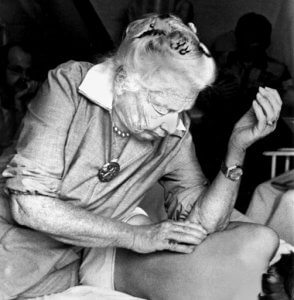lesson content in text
Nowadays, fascia is the most hyped-up topic in the world of movement. And to be honest, it deserves all of the attention it gets, because it started a long-overdue shift in the way we think about movement, musculoskeletal disorders and the body in general.
So what is fascia? It is a type of thin, cellophane-like connective tissue, and it enmeshes the whole body in multiple layers, like a giant 3D web. You know that wavy artwork on the guitarstrength website? It’s something like that.
It wraps around muscle fibers, muscle groups and internal organs, connecting them all together.

If you go and buy fresh meat, you will find a sticky, half-transparent, whitish layer below the skin and between muscles. That’s fascia.
And fascia is important, because it’s condition largely determines how the body moves and functions. It’s also the most pain-sensitive tissue in the body.

This is how it looks under a microscope. It’s mostly made out of water, so it’s slippery and elastic. And this slipperiness is key, since fascia is the surface between muscles, bones, joints and even internal organs, and enables these tissues to slide over each other smoothly when we move around.
This might be difficult to understand, so let me show you an orange.

An orange is an excellent analogy: not only is the whole thing in a ‘bag of fascia’, but the segments (muscles, muscle groups) and the smaller fibers (muscle fibers) are, too.
Of course, an orange cannot move, because its sections and fibers are all stuck together! But if we really wanted this orange to be able to move, we could replace the pulp with muscles and break up the stuck-together layers of fascia between the segments. Frightening picture, I know, but this way you will never forget that you need healthy fascia for easy movement!
Fascia also influences the shape of the body. If we removed the fascia from around a muscle, that muscle would lay flat on a surface. Wrapping it in a mesh-like structure gives it shape, and ‘resting tone’.
This resting tone, or muscle tone, is particularly important: we need some tension in our body so that we don’t literally fall apart. Muscles work in the short term, but get tired after continuous use. Now, think of fascia like a special muscle that works in the long-term. It holds all of your body parts in place in an elastic equilibrium, with almost no energy expenditure. Muscles are like engines, and fascia is like a rubber band.
But fascia also reacts to external forces. If you pull on it for long enough, it will adapt by lengthening.
Think back to the previous lesson about sitting and monotony, and let’s connect the two: if you sit or play guitar or do any kind of monotonous, repetitive activity for long enough, your fascial system will adapt to it by becoming deformed, twisted, shortened or lengthened in some way. This introduces unnatural force transfer between body parts, and will probably induce some kind of negative symptom in the long run. But more on this in the next module!
And since fascia covers the entire body, wrapping every organ, muscle, nerve and blood vessel from head to toe, it’s easy to imagine how pulling on one end of it can cause change on the other side of the body. What does this mean?
It means that wrist pain, for example, may be caused by an imbalance in the shoulder or neck region, because as you can see in the picture, the two are directly related to each other through fascia. Another example would be that you might be prone to headaches because years ago you had a fall and broke your tailbone.
One of the pioneers of fascia research used to say:
Where you think it is, it ain’t.’
-Ida Rolf, one of the first pioneers of fascia research and bodywork
Think about this the next time you or your loved ones have musculoskeletal complaints!
So let’s summarize.
Fascia is important, because it directly influences:
- how the body moves
- whether muscles are tense or relaxed
- the metabolism of tissues
And as a result, the health and function of the body as a whole.
It loves diverse movement, and hates immobility.
A healthy, relaxed and hydrated fascial system allows the different layers of tissues to slide easily against one another, which enables body parts to move freely, have good circulation, and all that is important for health.
Conversely, a dehydrated, rigid fascial system results in reduced mobility, poor circulation, joint and muscle pain, bad posture and so on…needless to say, this leads to no good.
As a guitarist, it’s almost entirely certain that the fascial system in your arms (especially your forearms) is in bad shape. Later in the course, we will go over several methods that will help your fascial system to be healthier, because frankly, this is one of the keys to high performance and being pain-free.

 Where you think it is, it ain’t.’
Where you think it is, it ain’t.’